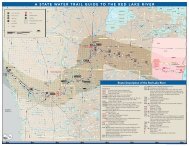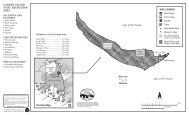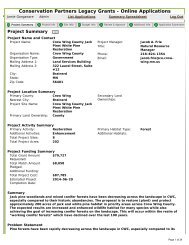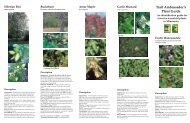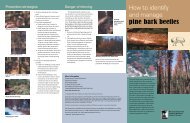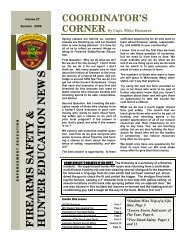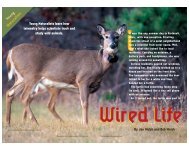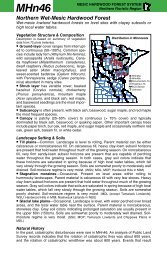Beetles!
Beetles!
Beetles!
You also want an ePaper? Increase the reach of your titles
YUMPU automatically turns print PDFs into web optimized ePapers that Google loves.
y Val Cervenka<br />
Beetlemania!<br />
Young<br />
naturalists<br />
▼<br />
Photography<br />
by Bill Johnson<br />
I’m a huge beetles fan. Oh, I love the Beatles<br />
too, but insects in the group Coleoptera (co-lee-OPter-ah)<br />
are the real rock stars of the animal kingdom.<br />
The best thing about beetles is that you will always<br />
be able to discover some you have never seen before<br />
because there are so many different kinds, or species.<br />
Depending on where you live, you can find hundreds<br />
of species of beetles in your own back yard.<br />
Look for them on flowers, under the bark of dead<br />
trees, under stones, in ponds, or even on a dead animal.<br />
Some colorful beetles shine like brilliant jewels.<br />
Some beetles are hidden because their earthy colors<br />
blend with the ground, trees, or rocks. Start your<br />
beetle search by looking for the beetles pictured on<br />
the following pages, all found in Minnesota.<br />
Clockwise from top left: The bright markings of the red milkweed<br />
beetle (Tetraopes tetrophthalmus) warn away predators. Blister<br />
beetles like this Epicauta pennsylvanica secrete a chemical that<br />
causes skin blisters. Long-horned beetles, such as this Eburia<br />
quadrigeminata, are named for their very long antennae,<br />
which can be twice as long as the beetle’s body. Top this page:<br />
Tylonotus bimaculatus is known as the privet borer. Bottom:<br />
Homaeotarsus bicolor is a rove beetle.<br />
54 Minnesota Conservation Volunteer November–December 2013 55
Wing Covers<br />
Coleoptera is the name that the<br />
ancient philosopher Aristotle gave<br />
to beetles. It comes from the Greek<br />
words koleon, meaning “sheath,”<br />
and ptera, meaning “wings.” Sheath<br />
wings are the beetle’s hard wing covers,<br />
or elytra. The wing covers protect<br />
the delicate hind wings. When<br />
not using its hind wings to fly, the<br />
beetle folds them beneath its elytra.<br />
No other insect species has such<br />
wings with covers.<br />
Click beetles make a clicking sound when<br />
flipping into the air to startle and scare<br />
away predators. Left: The eyed click beetle<br />
(Alaus oculatus) also has large fake<br />
eyes called eyespots behind its head. The<br />
eyespots can frighten off predators that<br />
mistake the beetle for a bigger creature.<br />
Opposite page, clockwise from top<br />
right: Psuedanostirus hieroglyphicus,<br />
another click beetle, has marks on<br />
its wing covers that look like ancient<br />
Egyptian writing called hieroglyphics.<br />
One of Minnesota’s native lady beetles<br />
is the cream-spotted lady beetle (Calvia<br />
quatuordecimguttata). This species can<br />
be either brown with cream-colored spots<br />
or red with black spots. Net-winged beetles<br />
like Calopteron discrepans have veiny<br />
wing covers, or elytra.<br />
56 Minnesota Conservation Volunteer<br />
57
<strong>Beetles</strong> Have Niches<br />
<strong>Beetles</strong> are incredibly diverse and adaptable<br />
to their surroundings. The assorted shapes<br />
and sizes of their legs, wings, antennae, and<br />
mouthparts allow them to live almost anywhere<br />
on Earth. They can be found in small<br />
spaces called niches within all kinds of habitats.<br />
Oceans and polar regions are just about<br />
the only places beetles have not turned up.<br />
With their chewing mouthparts, beetles<br />
can eat all kinds of things. Many eat plants,<br />
pollen, and fruit. Some beetles are predators<br />
of other insects. Others browse on<br />
fungi and lichens. Some beetles prefer animal<br />
remains and dung or are parasites that<br />
live on other insects.<br />
Size also contributes to the success of<br />
these amazing creatures. Small critters need<br />
less space, so they can find more niches in<br />
the habitat. The tiniest feather-winged beetles<br />
are less than 1⁄₁₆ of an inch long. They<br />
turn up in forest floor litter, under bark, and<br />
in dung and compost. They feed on fungus<br />
spores and mold. In South America the<br />
giant long-horned beetle can grow to more<br />
than 6 inches in length. In Minnesota the<br />
large tile-horned prionus, which eats the<br />
roots of oak and other hardwood trees, can<br />
be larger than 2 inches.<br />
Top left: The grape pelidnota (Pelidnota punctata) is<br />
a common scarab beetle. Bottom left: The sumac flea<br />
beetle (Blepharida rhois) has broad hind legs built for<br />
jumping. Right: The Polydrusus impressifrons weevil<br />
has light-reflecting scales that shimmer.<br />
59
Super Populations<br />
The world has more small plants and<br />
animals than big ones. And small<br />
ones come in more varieties. About<br />
5,400 species of mammals and approximately<br />
10,000 bird species live<br />
around the world. There are so many<br />
species of insects that scientists have<br />
not been able to find and name all<br />
of them. Scientists estimate between<br />
1 million and 80 million insect species<br />
live on Earth. About 40 percent<br />
(400,000 to 32 million) of those are<br />
beetle species. Obviously, insects—<br />
and particularly the beetles—rule! nV<br />
Top left: Macrosiagon limbatum has comb-like<br />
antennae, which help this beetle find food. Top<br />
right: The hollyhock weevil (Apion longirostre)<br />
is a straight-snouted weevil. It has chewing<br />
mouthparts at the tip of its long snout. Middle,<br />
left to right: Known as pinchingbugs, male stag<br />
beetles like this Lucanus capreolus have large<br />
jaws. The six-spotted tiger beetle (Cicindela<br />
sexguttata) is common in Minnesota.<br />
Long-horned beetles such as this privet borer<br />
(Tylonotus bimaculatus) help recycle dead<br />
and dying wood. Bottom left: Almost every<br />
acorn contains a weevil in the genus Curculio.<br />
Bottom right: Megacyllene robiniae, a<br />
longhorn beetle, is known as the locust borer.<br />
60<br />
Teachers resources:<br />
Teachers guide:<br />
www.mndnr.gov/young_naturalists<br />
More on beetles and other insects:<br />
www.bugguide.net




